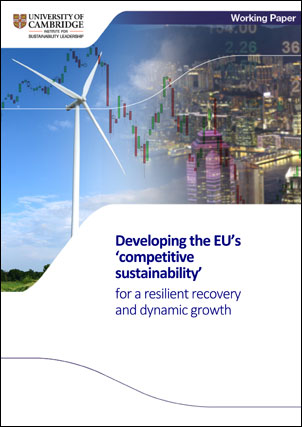17 November 2020 – This thought-starter paper has been prepared with a view to sharing some initial ideas on the a concept of ‘competitive sustainability’, which lies at the heart of the European Green Deal (EGD) and the EU’s growth strategy. Upcoming investment and policy decisions, such as those on the Covid-19 Recovery and Resilience Plans (RRPs) and the new EU Industrial Strategy need to focus on this new approach to competitiveness to ensure the EU stands to secure advantage and benefit from the economic opportunities, jobs and emissions reductions from the transition to climate neutrality.
About
This initial study finds that for policy and investment to be optimally targeted, there should be a clear set of publicly available, comparable and comprehensive analyses and assessments of the competitiveness dimension of the transition being undertaken in the Green Deal, along with explicit assumptions about alternative options. The report provides a definition of ‘competitive sustainability’, and suggests success in the area can be measured by looking at:
- enterprise-level technology and business model leadership in global growth markets
- infrastructure development enabling cross-sectoral productivity and economy-wide gross domestic product (GDP) growth
- strength of domestic industrial ecosystems in generating increased and high-quality employment and additional value-added as a proportion of their global value chains.
Key findings
- The EU’s policy leadership positions it well: The EU has success stories and much potential in the area of ‘competitive sustainability’. It also has strong collaborative instincts, networks and endeavours to ensure that international frameworks enable collaboration as well as competition, too. This combination can enable it to support global public investments on key early stage research, and also to align and allow market-based solutions to thrive as a result.
- The EU should not be complacent about its strengths – or those of its competitors: In many areas across these three dimensions of competitive sustainability, other economies are clearly very strong and well positioned to secure advantage, as they have on occasion done before.
- The EU lacks a full picture of its competitive sustainability: Evidence on competitive sustainability is far from complete, and what does exist is hard to compare or aggregate. As a result, the EU lacks a sufficiently clear overall picture and shared understanding of where it is leading or lagging internationally, has high or low potential, or has new or unmet strategic needs.
- Further analysis needs to feed into immediate policy and investment decisions: The EU, and the European Commission in particular, should develop a fuller analysis of competitive sustainability. With this, it can apply its logic to its economic strategy and policies across the full range of the European Semester process, including its Recovery and Resilience Plans and new Industrial Strategy in order to make the best decisions between alternatives for its enabling framework and direct investment.
"The race to climate neutrality by mid-century has now begun in earnest with China, Japan and South Korea, and soon the US, joining the EU in targeting it and flexing their economic muscles accordingly. The EU's approach to competitive sustainability is more important than ever to its own growth, industrial and recovery strategies. Our new paper asks what this new concept means in practice and what the EU should do to realise its full potential."
Martin Porter, Executive Chair, CISL Brussels
"We need to tackle the climate crisis. But while doing so European companies and industrial ecosystems can and should thrive in the international markets. The concept of competitive sustainability allows us to think strategically about these issues, which are detailed in the new report."
Outi Haanperä, Leading specialist, Climate and Nature Solutions, Finnish Innovation Fund (Sitra)
"The race to the top has started. The EU and the European industry are in a good position to thrive as demand for sustainable solutions keeps on growing in Europe and beyond. But if the EU is to turn the green transition into a real source of competitiveness, it should agree on the definition, the elements and the means for achieving ‘competitive sustainability’.”
Annika Hedberg, Head of a Sustainable Prosperity for Europe Programme, European Policy Centre
Citing this report
Please refer to this working paper as: University of Cambridge Institute for Sustainability Leadership (CISL). (2020). Developing the EU’s ‘competitive sustainability’ for a resilient recovery and dynamic growth. Cambridge, UK: the Cambridge Institute for Sustainability Leadership.




